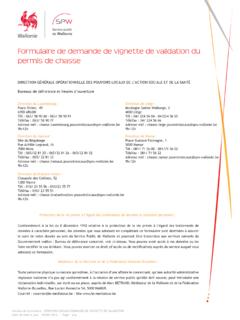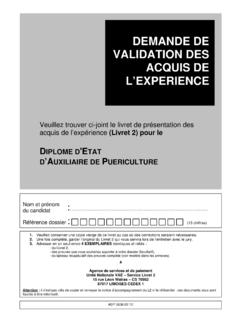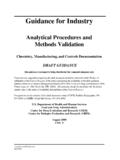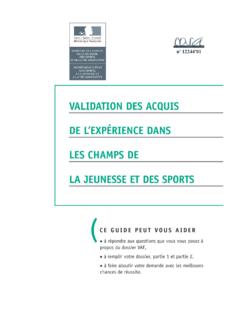Transcription of A Practical Approach to Biological Assay Validation
1 A Practical Approach to Biological Assay Validation Joke Ederveen Sponsored by the Dutch Ministry of Housing, Spatial Planning and the Environment (VROM) 2010 Progress report number 08090 A Practical Approach to Biological Assay Validation A Practical Approach to Biological Assay Validation Author: Ederveen Contact: Joke Ederveen Progress, Project Management & Engineering Box 60; 2130 AB Hoofddorp, the Netherlands Tel. +31 23 563 5016 / +31 6 4637 7226 Steering committee: Dr. Bleijs, RIVM, GMO Office, Bilthoven Dr. Kootstra, Academic Medical Center, University of Amsterdam Drs. D. Louz, RIVM, GMO Office, Bilthoven Drs. van Mourik, Sanquin Pharmaceutical Services, Amsterdam Dr. Peeters, Central Veterinary Institute, Lelystad Ing. Wassenaar, RIVM, GMO Office, Bilthoven Dr. G. van Willigen, Leiden University Medical Center Sponsor: This report has been ordered and sponsored by the Dutch Ministry of Housing, Spatial Planning and the Environment (VROM).
2 Acknowledgement: The assistance of Dr. Rits in the preparation of this manuscript is highly appreciated. Hoofddorp, May 2010 A Practical Approach to Biological Assay Validation 2 Summary This report is written from the perspective that ' Validation is a familiar concept, but in practice often interpreted and applied in different ways amongst scientists, government officials involved in authorizing experimental laboratory work, and inspectors. The document is meant as Practical guide for the execution and implementation of Biological Assay Validation in laboratory research. Extensive literature on the subject of Assay Validation is available, but its content is often too abstract or not specific enough or not useful for the aimed type of research. Therefore, in this report, the basic concepts of ' Validation and ' Validation performance characteristics are explained in simple terms and elucidated by examples.
3 In the report the possible types of Assay categories are illustrated and it is shown how each laboratory experiment can be assigned to one of these categories. Depending on the purpose of the Assay , the relevant characteristics of an Assay are determined that have to be validated. Assay Validation is in fact a continuous process. The Validation process starts with a description of the purpose of the method, followed by the development of the Assay and the definition of the performance characteristics. It continues with documentation of the methodology and the Validation results. During the in-use phase of the Assay , there is continuous monitoring to assure that the Assay still generates results in accordance with the performance characteristics as originally determined. Revalidation is applicable if the method is changed, or has been out of use for a while, when it is applied for another material or for a new purpose.
4 For clarity, in this report the Assay Validation process is systematically subdivided in five different Validation phases, which is suitable for Validation of Biological assays in general. The Validation process is demonstrated by detailed, concrete examples of frequently used Biological assays. 3 Samenvatting Dit rapport is geschreven vanuit het perspectief dat het begrip validatie breed bekend is, maar in de praktijk op verschillende manieren ge nterpreteerd en gehanteerd wordt door onderzoekers, overheidsfunctionarissen betrokken bij het verlenen van toestemming voor experimentele laboratoriumwerkzaamheden en inspecteurs. Het rapport is bedoeld als een concrete handleiding voor de uitvoering en implementatie van validatie van biologische assays in laboratoriumonderzoek. Er bestaat ruimschoots literatuur over dit onderwerp, maar vaak is de inhoud te abstract of niet specifiek voor de betreffende methode of niet bruikbaar voor de beoogde toepassing van het onderzoek.
5 Daarom worden in dit rapport de begrippen 'validatie en 'validatie prestatiekenmerken in eenvoudige termen uitgelegd en zijn illustratieve voorbeelden opgenomen. Het rapport behandelt vier mogelijke soorten Assay categorie n waarin elk laboratoriumexperiment afhankelijk van de vraagstelling ingedeeld kan worden. Het type Assay en het beoogde doel bepalen welke relevante eigenschappen van de Assay gevalideerd moeten worden. Assay validatie is in feite een continu proces: het validatieproces begint met de omschrijving van het doel van de methode, gevolgd door het ontwikkelen van de test en het bepalen van de prestatie-karakteristieken. Het proces wordt voortgezet met het documenteren van de methode en het vastleggen van de validatieresultaten. Tijdens de gebruiksfase van de Assay wordt voortdurend gemonitord om vast te stellen of de Assay nog steeds aan de prestatiekenmerken, zoals deze oorspronkelijk zijn bepaald en vastgelegd, wordt voldaan.
6 Hervalidatie vindt plaats als de methode wordt aangepast, als de Assay een tijdlang niet is gebruikt of als de Assay gebruikt gaat worden met een ander type materiaal of voor een andere beoogde toepassing. Voor de duidelijkheid is het validatieproces in dit rapport systematisch onderverdeeld in vijf verschillende validatiefases een concept dat bruikbaar is voor de validatie van biologische assays in het algemeen. Het validatieproces wordt gedemonstreerd aan de hand van concrete voorbeelden van veel toegepaste biologische assays. A Practical Approach to Biological Assay Validation 4 Purpose and scope The purpose of this document is to provide general understanding about Biological Assay Validation . Illustrative Practical examples are shown of how the concept of Validation can be applied to commonly used assays: virus infectivity assays, immunoassays (ELISA) and polymerase chain reaction (PCR) assays. This document focuses on the use of these assays for the detection, identification or quantitation of viruses in the context of activities with genetically modified organisms (GMOs) in the laboratory.
7 This report is meant as a guidance document for scientists, laboratory personnel, ( Biological ) safety officers, auditors and regulatory bodies for developing a Validation plan. This report should not be regarded as a prescription for the way specific assays should be validated, because this is context-dependent and mainly driven by the purpose of the Assay , the scientific questions asked and the risks associated with the outcome of the Assay . Although examples are provided in the report, the selection of the Assay or test method that is best suited for a particular application, as well as to which extent feasibility or Validation studies have to be done, is beyond the scope of this report. Table of contents 5 Table of contents 2 Samenvatting .. 3 Purpose and scope .. 4 Table of contents .. 5 PART I: Validation PRINCIPLES AND Validation PARAMETERS .. 8 1 9 2 The Validation process .. 11 Introduction on Assay Validation .
8 11 To what extent is Validation required? .. 11 Assay 14 Assay development, performance and 16 Method verification .. 21 Concluding remarks .. 22 3 Assay Validation 23 Accuracy .. 23 Precision; repeatability, inter- Assay variation, reproducibility .. 26 Linearity and range of the 33 Specificity .. 34 Limit of detection (detection limit) .. 35 Limit of quantitation .. 37 38 Application of Validation 40 4 42 Raw data .. 42 Specifications .. 42 Procedures .. 43 44 A Practical Approach to Biological Assay Validation 6 PART II: EXAMPLES OF Biological Assay 46 5 Test for detection of virus infectivity (TCID50 Assay ).. 47 Introduction .. 47 Validation parameters .. 48 Stage 1. Selection and feasibility .. 49 Stage 2. Development and standardization .. 53 Stage 3. Performance qualification .. 55 Stage 4. Performance Validation .. 59 Stage 5. Maintenance and improvement .. 60 Method verification .. 60 Points to 60 6 ELISA for HIV-p24.
9 64 Introduction .. 64 Validation parameters .. 64 Stage 1. Selection and feasibility .. 65 Stage 2. Development and standardization .. 66 Stage 3. Performance qualification .. 71 Stage 4. Performance Validation .. 72 Stage 5. Maintenance and improvement .. 72 Method verification .. 73 Points to 75 7 Polymerase Chain Reaction: PERT Assay .. 78 Introduction .. 78 Validation parameters .. 78 Stage 1. Selection and feasibility .. 79 Stage 2. Development and standardization .. 81 Stage 3. Performance qualification .. 86 Stage 4. Performance Validation .. 88 Table of contents Stage 5. Maintenance and improvement .. 89 Method verification .. 89 Points to 90 PART III: GENERAL ISSUES RELATED TO Assay Validation .. 93 8 General remarks and recommendations .. 94 Reference standards .. 94 Training .. 94 Contract Research Organisations (CROs) .. 94 9 Glossary .. 96 Terms and definitions .. 96 Abbreviations .. 99 10 References.
10 102 A Practical Approach to Biological Assay Validation 8 PART I: Validation PRINCIPLES AND Validation PARAMETERS In this part, the general Validation process and principles are described in order to help the reader in gaining understanding of what Assay Validation is and what parameters are necessary for certain applications for the different Assay categories. Chapter 1 is a general introduction. In Chapter 2 the different stages in the Assay Validation process are explained and the differences in requirements for both an entire new method and an existing method are elucidated. Chapter 3 is an outline of Validation parameters. It explains the parameters in basic terms for those who are not yet familiar with the concept of Validation or want to refresh their knowledge of this subject. Chapter 4 focuses on the advantages of good documentation. It covers documentation aspects related to Validation and contains recommendations for the use of standard procedures, Validation protocols, and reports.





